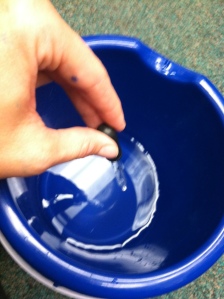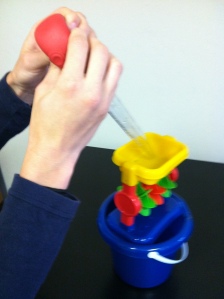But how do you know whether your child’s grasp is appropriate? The first thing to recognize is that children’s development of writing utensil grasp tends to follow a particular progression. Toddlers first grasp a crayon or marker by wrapping their whole fist around it, and scribbling with the pinky side of their hand toward the paper. This is called a palmar supinate, fisted, barrel, or cylindrical grasp, and it tends to begin around 12-16 months and is illustrated below.
Next, as children experiment with grasp and develop more dexterity in their forearm, wrist, and hand, they learn that they get more precision by turning the palm downward, with the pointer finger toward the pencil tip and the paper. This is called a digital pronate grasp and can be expected to emerge between the ages of 2 and 3.
Later, as the many small muscles of the hand develop increased strength and coordination, the child develops what is known as the static tripod or quadrupod grasp, in which the thumb is opposed to the next 2 or 3 fingers, with the pinky side of the hand toward the paper and the top of the pencil extending up from the space between the thumb and index finger. This grasp generally emerges somewhere between 3-4 years. Finally, as the child develops even more dexterity, the grasp becomes a dynamic tripod or quadrupod, in which the pencil is held in the same general orientation as the previous grasp, but the wrist and fingers are now able to create small, refined movements rather than depending on using the arm as a whole. This grasp tends to develop between 4 and 6 years of age.
When to consider OT
Just because your child’s grasp doesn’t follow the developmental pattern above does not necessarily mean they will have problems requiring intervention. There are other grasps that may also be considered functional, and there are children with appropriate grasps that still develop problems due to other factors. Your OT can help determine the best way to help your child develop a functional grasp, including working on other factors that may help, such as posture, adaptive aids, or strengthening activities. Here are some other things to look for that might signal a problem worth looking into:
– Child frequently putting utensils down to wiggle or shake out fingers
– Writing that is too light or too heavy (i.e. too light to read, or heavy enough to break the pencil/crayon)
– Writing with arm not resting on the table
– Using the whole arm to write rather than wrist and hand movements
– Poor posture
Please don’t hesitate to ask your therapist if you are concerned about your child’s writing utensil grasp- we’re here to help!








